Organisational Practice Of Google And Trompenaars Model
VerifiedAdded on 2022/08/20
|16
|4105
|15
AI Summary
Contribute Materials
Your contribution can guide someone’s learning journey. Share your
documents today.
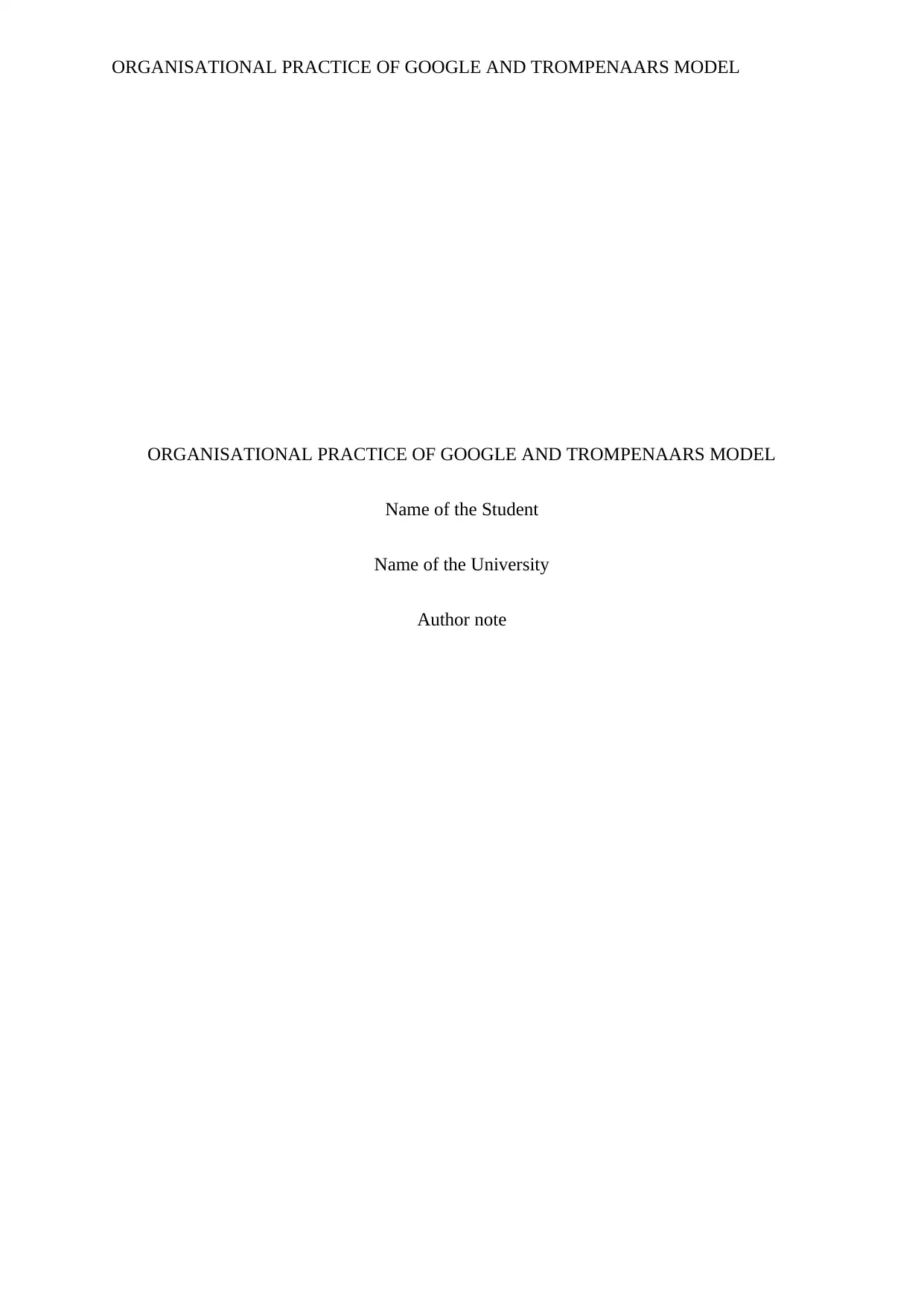
ORGANISATIONAL PRACTICE OF GOOGLE AND TROMPENAARS MODEL
ORGANISATIONAL PRACTICE OF GOOGLE AND TROMPENAARS MODEL
Name of the Student
Name of the University
Author note
ORGANISATIONAL PRACTICE OF GOOGLE AND TROMPENAARS MODEL
Name of the Student
Name of the University
Author note
Secure Best Marks with AI Grader
Need help grading? Try our AI Grader for instant feedback on your assignments.

1ORGANISATIONAL PRACTICE OF GOOGLE AND TROMPENAARS MODEL
Executive Summary
In this paper, the organizational culture of Google is analysed by using the Trompenaars
Model. The working culture of Google is known to be one of the best places to work in. The
dimensions of the model used to analyse the working culture of the company, specific v/s
diffuse, achievement v/s ascription, neutral v/s emotional and sequential time v/s
synchronous time. These four dimensions are used as they represent the culture of the
company in the most suitable manner.
Executive Summary
In this paper, the organizational culture of Google is analysed by using the Trompenaars
Model. The working culture of Google is known to be one of the best places to work in. The
dimensions of the model used to analyse the working culture of the company, specific v/s
diffuse, achievement v/s ascription, neutral v/s emotional and sequential time v/s
synchronous time. These four dimensions are used as they represent the culture of the
company in the most suitable manner.

2ORGANISATIONAL PRACTICE OF GOOGLE AND TROMPENAARS MODEL
Table of Contents
Background................................................................................................................................3
Introduction................................................................................................................................3
Organisational Culture...........................................................................................................3
Organisational Practices.........................................................................................................4
Discussion..................................................................................................................................5
Trompenaars Model...............................................................................................................5
Universalism v/s Particularism..........................................................................................6
Individualism v/s Communitarianism................................................................................6
Specific v/s Diffuse............................................................................................................7
Neutral v/s Emotional........................................................................................................7
Achievement v/s Ascription...............................................................................................8
Sequential time v/s Synchronous time...............................................................................8
Internal direction v/s External direction.............................................................................8
Analysis of Google’s Culture through Trompenaars Model..................................................9
Specific v/s Diffuse............................................................................................................9
Achievement v/s Ascription.............................................................................................10
Neutral v/s Emotional......................................................................................................11
Sequential time v/s Synchronous time.............................................................................11
Conclusion................................................................................................................................12
Recommendations....................................................................................................................12
References................................................................................................................................14
Table of Contents
Background................................................................................................................................3
Introduction................................................................................................................................3
Organisational Culture...........................................................................................................3
Organisational Practices.........................................................................................................4
Discussion..................................................................................................................................5
Trompenaars Model...............................................................................................................5
Universalism v/s Particularism..........................................................................................6
Individualism v/s Communitarianism................................................................................6
Specific v/s Diffuse............................................................................................................7
Neutral v/s Emotional........................................................................................................7
Achievement v/s Ascription...............................................................................................8
Sequential time v/s Synchronous time...............................................................................8
Internal direction v/s External direction.............................................................................8
Analysis of Google’s Culture through Trompenaars Model..................................................9
Specific v/s Diffuse............................................................................................................9
Achievement v/s Ascription.............................................................................................10
Neutral v/s Emotional......................................................................................................11
Sequential time v/s Synchronous time.............................................................................11
Conclusion................................................................................................................................12
Recommendations....................................................................................................................12
References................................................................................................................................14

3ORGANISATIONAL PRACTICE OF GOOGLE AND TROMPENAARS MODEL
Background
Google was founded in the year 1995, initially known as Backrub, and in 1996, the
name was changed to Google while it was incorporated on September 4, 1998 (About
Google, 2020). The site is founded by Larry Page and Sergey Brin. Google has a lot of
subsidiaries that include, YouTube, Gmail, Maps, Chrome, Drive, Translate, and many more.
The company is coming up with devices like Google Home, Pixel Phones and Chromecast.
The headquarters of the company is in California, USA. The current CEO of Google is
Sundar Pichai. It is one of the few companies in the technology sector that is growing at such
a fast pace. The mission of the company is to organise all the information that is available in
the world, make it accessible to everyone, and make it useful (About Google, 2020).
Introduction
Organisational Culture
Organisational culture can be defined as a system that is a base of shared values,
beliefs and assumptions that affect the working of the employees. It is the fundamental core
of the company and is known as the working personality of the company (Whelan, 2016).
The working environment of Google is defined as one of the best environments to work in.
The company takes care of its employees and encourages them to work better and come up
with new ideas that can be developed further. The employees are given innovation time off
for developing their new ideas to create a creative environment where people have a chance
to learn and grow (Kuratko., Hornsby., & Covin., 2014). The company provides the
employees with free healthcare benefits, there are on site doctor present, food to the
employees, gyms and swimming pools are there on the site, nap pods and places where the
employees can relax and play games (Bock., 2015). Google also offers many compensations
Background
Google was founded in the year 1995, initially known as Backrub, and in 1996, the
name was changed to Google while it was incorporated on September 4, 1998 (About
Google, 2020). The site is founded by Larry Page and Sergey Brin. Google has a lot of
subsidiaries that include, YouTube, Gmail, Maps, Chrome, Drive, Translate, and many more.
The company is coming up with devices like Google Home, Pixel Phones and Chromecast.
The headquarters of the company is in California, USA. The current CEO of Google is
Sundar Pichai. It is one of the few companies in the technology sector that is growing at such
a fast pace. The mission of the company is to organise all the information that is available in
the world, make it accessible to everyone, and make it useful (About Google, 2020).
Introduction
Organisational Culture
Organisational culture can be defined as a system that is a base of shared values,
beliefs and assumptions that affect the working of the employees. It is the fundamental core
of the company and is known as the working personality of the company (Whelan, 2016).
The working environment of Google is defined as one of the best environments to work in.
The company takes care of its employees and encourages them to work better and come up
with new ideas that can be developed further. The employees are given innovation time off
for developing their new ideas to create a creative environment where people have a chance
to learn and grow (Kuratko., Hornsby., & Covin., 2014). The company provides the
employees with free healthcare benefits, there are on site doctor present, food to the
employees, gyms and swimming pools are there on the site, nap pods and places where the
employees can relax and play games (Bock., 2015). Google also offers many compensations
Secure Best Marks with AI Grader
Need help grading? Try our AI Grader for instant feedback on your assignments.
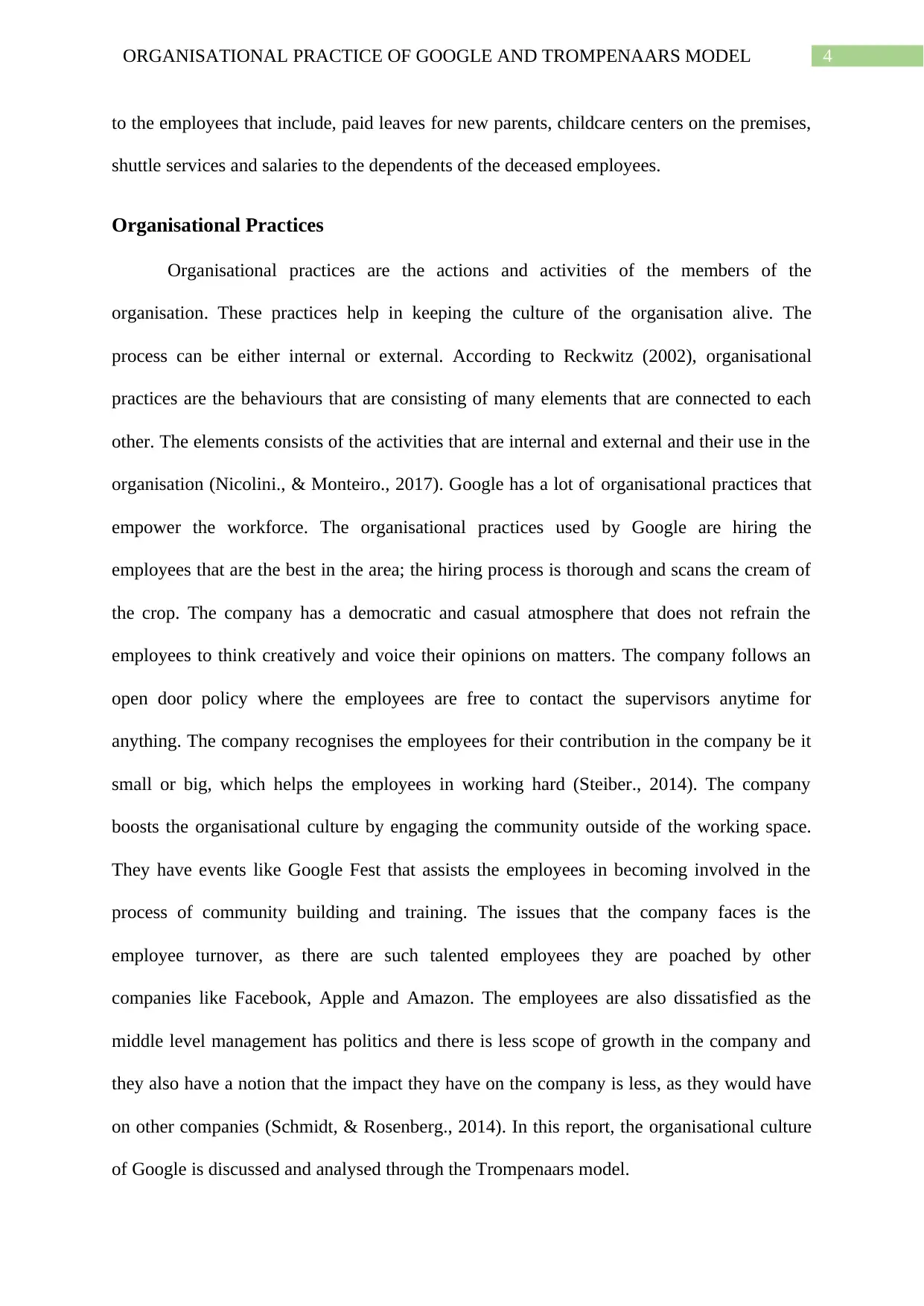
4ORGANISATIONAL PRACTICE OF GOOGLE AND TROMPENAARS MODEL
to the employees that include, paid leaves for new parents, childcare centers on the premises,
shuttle services and salaries to the dependents of the deceased employees.
Organisational Practices
Organisational practices are the actions and activities of the members of the
organisation. These practices help in keeping the culture of the organisation alive. The
process can be either internal or external. According to Reckwitz (2002), organisational
practices are the behaviours that are consisting of many elements that are connected to each
other. The elements consists of the activities that are internal and external and their use in the
organisation (Nicolini., & Monteiro., 2017). Google has a lot of organisational practices that
empower the workforce. The organisational practices used by Google are hiring the
employees that are the best in the area; the hiring process is thorough and scans the cream of
the crop. The company has a democratic and casual atmosphere that does not refrain the
employees to think creatively and voice their opinions on matters. The company follows an
open door policy where the employees are free to contact the supervisors anytime for
anything. The company recognises the employees for their contribution in the company be it
small or big, which helps the employees in working hard (Steiber., 2014). The company
boosts the organisational culture by engaging the community outside of the working space.
They have events like Google Fest that assists the employees in becoming involved in the
process of community building and training. The issues that the company faces is the
employee turnover, as there are such talented employees they are poached by other
companies like Facebook, Apple and Amazon. The employees are also dissatisfied as the
middle level management has politics and there is less scope of growth in the company and
they also have a notion that the impact they have on the company is less, as they would have
on other companies (Schmidt, & Rosenberg., 2014). In this report, the organisational culture
of Google is discussed and analysed through the Trompenaars model.
to the employees that include, paid leaves for new parents, childcare centers on the premises,
shuttle services and salaries to the dependents of the deceased employees.
Organisational Practices
Organisational practices are the actions and activities of the members of the
organisation. These practices help in keeping the culture of the organisation alive. The
process can be either internal or external. According to Reckwitz (2002), organisational
practices are the behaviours that are consisting of many elements that are connected to each
other. The elements consists of the activities that are internal and external and their use in the
organisation (Nicolini., & Monteiro., 2017). Google has a lot of organisational practices that
empower the workforce. The organisational practices used by Google are hiring the
employees that are the best in the area; the hiring process is thorough and scans the cream of
the crop. The company has a democratic and casual atmosphere that does not refrain the
employees to think creatively and voice their opinions on matters. The company follows an
open door policy where the employees are free to contact the supervisors anytime for
anything. The company recognises the employees for their contribution in the company be it
small or big, which helps the employees in working hard (Steiber., 2014). The company
boosts the organisational culture by engaging the community outside of the working space.
They have events like Google Fest that assists the employees in becoming involved in the
process of community building and training. The issues that the company faces is the
employee turnover, as there are such talented employees they are poached by other
companies like Facebook, Apple and Amazon. The employees are also dissatisfied as the
middle level management has politics and there is less scope of growth in the company and
they also have a notion that the impact they have on the company is less, as they would have
on other companies (Schmidt, & Rosenberg., 2014). In this report, the organisational culture
of Google is discussed and analysed through the Trompenaars model.
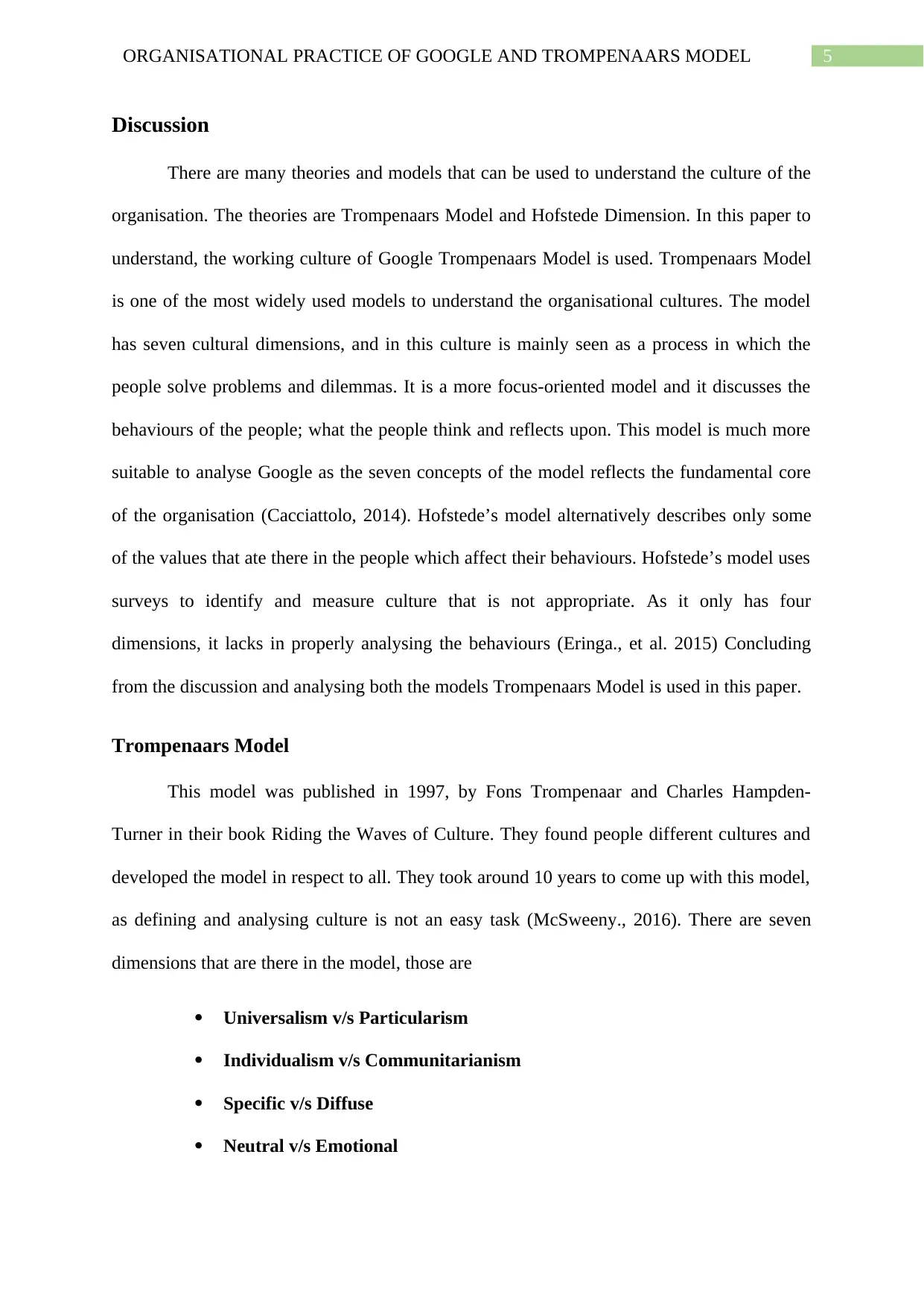
5ORGANISATIONAL PRACTICE OF GOOGLE AND TROMPENAARS MODEL
Discussion
There are many theories and models that can be used to understand the culture of the
organisation. The theories are Trompenaars Model and Hofstede Dimension. In this paper to
understand, the working culture of Google Trompenaars Model is used. Trompenaars Model
is one of the most widely used models to understand the organisational cultures. The model
has seven cultural dimensions, and in this culture is mainly seen as a process in which the
people solve problems and dilemmas. It is a more focus-oriented model and it discusses the
behaviours of the people; what the people think and reflects upon. This model is much more
suitable to analyse Google as the seven concepts of the model reflects the fundamental core
of the organisation (Cacciattolo, 2014). Hofstede’s model alternatively describes only some
of the values that ate there in the people which affect their behaviours. Hofstede’s model uses
surveys to identify and measure culture that is not appropriate. As it only has four
dimensions, it lacks in properly analysing the behaviours (Eringa., et al. 2015) Concluding
from the discussion and analysing both the models Trompenaars Model is used in this paper.
Trompenaars Model
This model was published in 1997, by Fons Trompenaar and Charles Hampden-
Turner in their book Riding the Waves of Culture. They found people different cultures and
developed the model in respect to all. They took around 10 years to come up with this model,
as defining and analysing culture is not an easy task (McSweeny., 2016). There are seven
dimensions that are there in the model, those are
Universalism v/s Particularism
Individualism v/s Communitarianism
Specific v/s Diffuse
Neutral v/s Emotional
Discussion
There are many theories and models that can be used to understand the culture of the
organisation. The theories are Trompenaars Model and Hofstede Dimension. In this paper to
understand, the working culture of Google Trompenaars Model is used. Trompenaars Model
is one of the most widely used models to understand the organisational cultures. The model
has seven cultural dimensions, and in this culture is mainly seen as a process in which the
people solve problems and dilemmas. It is a more focus-oriented model and it discusses the
behaviours of the people; what the people think and reflects upon. This model is much more
suitable to analyse Google as the seven concepts of the model reflects the fundamental core
of the organisation (Cacciattolo, 2014). Hofstede’s model alternatively describes only some
of the values that ate there in the people which affect their behaviours. Hofstede’s model uses
surveys to identify and measure culture that is not appropriate. As it only has four
dimensions, it lacks in properly analysing the behaviours (Eringa., et al. 2015) Concluding
from the discussion and analysing both the models Trompenaars Model is used in this paper.
Trompenaars Model
This model was published in 1997, by Fons Trompenaar and Charles Hampden-
Turner in their book Riding the Waves of Culture. They found people different cultures and
developed the model in respect to all. They took around 10 years to come up with this model,
as defining and analysing culture is not an easy task (McSweeny., 2016). There are seven
dimensions that are there in the model, those are
Universalism v/s Particularism
Individualism v/s Communitarianism
Specific v/s Diffuse
Neutral v/s Emotional
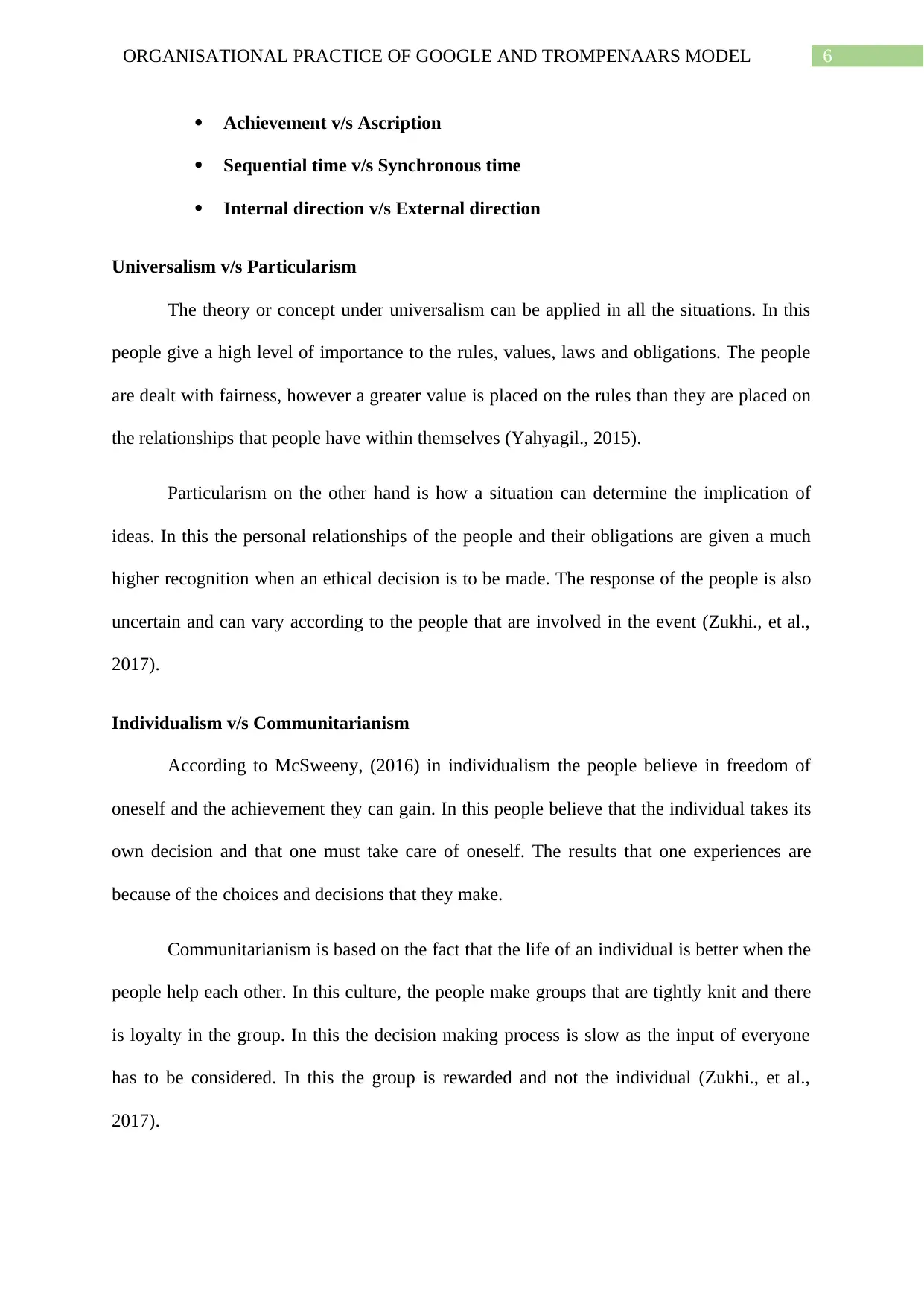
6ORGANISATIONAL PRACTICE OF GOOGLE AND TROMPENAARS MODEL
Achievement v/s Ascription
Sequential time v/s Synchronous time
Internal direction v/s External direction
Universalism v/s Particularism
The theory or concept under universalism can be applied in all the situations. In this
people give a high level of importance to the rules, values, laws and obligations. The people
are dealt with fairness, however a greater value is placed on the rules than they are placed on
the relationships that people have within themselves (Yahyagil., 2015).
Particularism on the other hand is how a situation can determine the implication of
ideas. In this the personal relationships of the people and their obligations are given a much
higher recognition when an ethical decision is to be made. The response of the people is also
uncertain and can vary according to the people that are involved in the event (Zukhi., et al.,
2017).
Individualism v/s Communitarianism
According to McSweeny, (2016) in individualism the people believe in freedom of
oneself and the achievement they can gain. In this people believe that the individual takes its
own decision and that one must take care of oneself. The results that one experiences are
because of the choices and decisions that they make.
Communitarianism is based on the fact that the life of an individual is better when the
people help each other. In this culture, the people make groups that are tightly knit and there
is loyalty in the group. In this the decision making process is slow as the input of everyone
has to be considered. In this the group is rewarded and not the individual (Zukhi., et al.,
2017).
Achievement v/s Ascription
Sequential time v/s Synchronous time
Internal direction v/s External direction
Universalism v/s Particularism
The theory or concept under universalism can be applied in all the situations. In this
people give a high level of importance to the rules, values, laws and obligations. The people
are dealt with fairness, however a greater value is placed on the rules than they are placed on
the relationships that people have within themselves (Yahyagil., 2015).
Particularism on the other hand is how a situation can determine the implication of
ideas. In this the personal relationships of the people and their obligations are given a much
higher recognition when an ethical decision is to be made. The response of the people is also
uncertain and can vary according to the people that are involved in the event (Zukhi., et al.,
2017).
Individualism v/s Communitarianism
According to McSweeny, (2016) in individualism the people believe in freedom of
oneself and the achievement they can gain. In this people believe that the individual takes its
own decision and that one must take care of oneself. The results that one experiences are
because of the choices and decisions that they make.
Communitarianism is based on the fact that the life of an individual is better when the
people help each other. In this culture, the people make groups that are tightly knit and there
is loyalty in the group. In this the decision making process is slow as the input of everyone
has to be considered. In this the group is rewarded and not the individual (Zukhi., et al.,
2017).
Paraphrase This Document
Need a fresh take? Get an instant paraphrase of this document with our AI Paraphraser
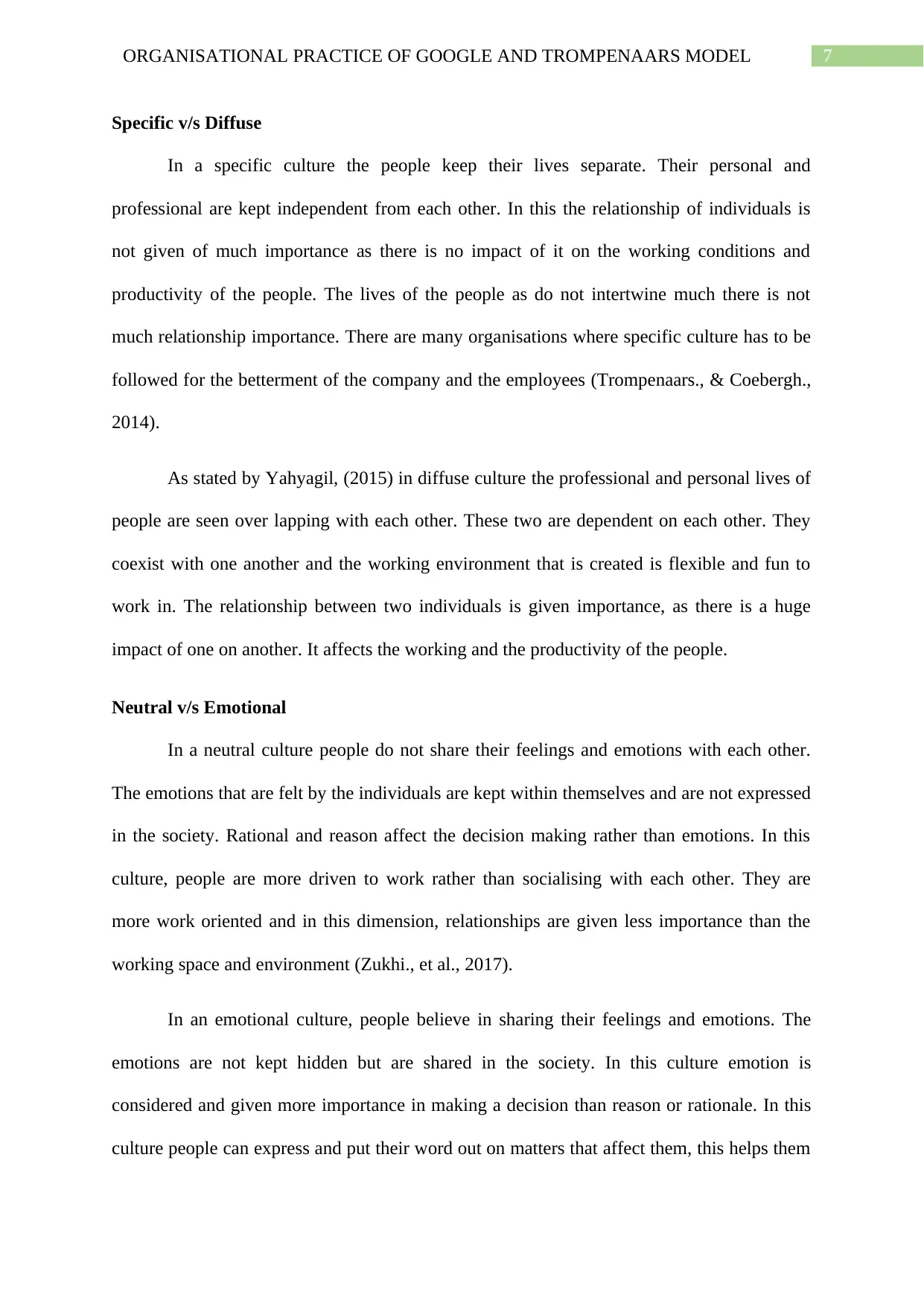
7ORGANISATIONAL PRACTICE OF GOOGLE AND TROMPENAARS MODEL
Specific v/s Diffuse
In a specific culture the people keep their lives separate. Their personal and
professional are kept independent from each other. In this the relationship of individuals is
not given of much importance as there is no impact of it on the working conditions and
productivity of the people. The lives of the people as do not intertwine much there is not
much relationship importance. There are many organisations where specific culture has to be
followed for the betterment of the company and the employees (Trompenaars., & Coebergh.,
2014).
As stated by Yahyagil, (2015) in diffuse culture the professional and personal lives of
people are seen over lapping with each other. These two are dependent on each other. They
coexist with one another and the working environment that is created is flexible and fun to
work in. The relationship between two individuals is given importance, as there is a huge
impact of one on another. It affects the working and the productivity of the people.
Neutral v/s Emotional
In a neutral culture people do not share their feelings and emotions with each other.
The emotions that are felt by the individuals are kept within themselves and are not expressed
in the society. Rational and reason affect the decision making rather than emotions. In this
culture, people are more driven to work rather than socialising with each other. They are
more work oriented and in this dimension, relationships are given less importance than the
working space and environment (Zukhi., et al., 2017).
In an emotional culture, people believe in sharing their feelings and emotions. The
emotions are not kept hidden but are shared in the society. In this culture emotion is
considered and given more importance in making a decision than reason or rationale. In this
culture people can express and put their word out on matters that affect them, this helps them
Specific v/s Diffuse
In a specific culture the people keep their lives separate. Their personal and
professional are kept independent from each other. In this the relationship of individuals is
not given of much importance as there is no impact of it on the working conditions and
productivity of the people. The lives of the people as do not intertwine much there is not
much relationship importance. There are many organisations where specific culture has to be
followed for the betterment of the company and the employees (Trompenaars., & Coebergh.,
2014).
As stated by Yahyagil, (2015) in diffuse culture the professional and personal lives of
people are seen over lapping with each other. These two are dependent on each other. They
coexist with one another and the working environment that is created is flexible and fun to
work in. The relationship between two individuals is given importance, as there is a huge
impact of one on another. It affects the working and the productivity of the people.
Neutral v/s Emotional
In a neutral culture people do not share their feelings and emotions with each other.
The emotions that are felt by the individuals are kept within themselves and are not expressed
in the society. Rational and reason affect the decision making rather than emotions. In this
culture, people are more driven to work rather than socialising with each other. They are
more work oriented and in this dimension, relationships are given less importance than the
working space and environment (Zukhi., et al., 2017).
In an emotional culture, people believe in sharing their feelings and emotions. The
emotions are not kept hidden but are shared in the society. In this culture emotion is
considered and given more importance in making a decision than reason or rationale. In this
culture people can express and put their word out on matters that affect them, this helps them
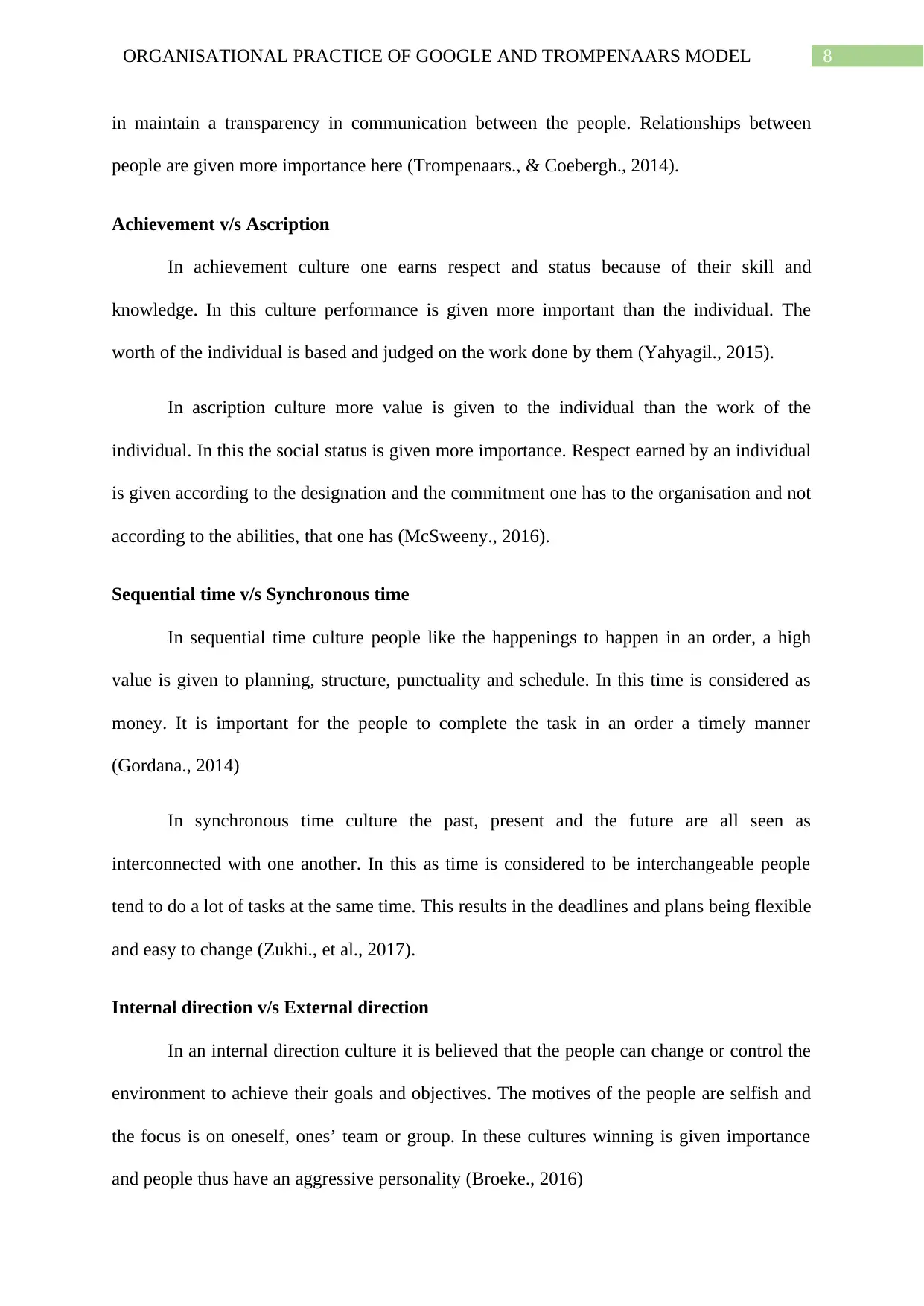
8ORGANISATIONAL PRACTICE OF GOOGLE AND TROMPENAARS MODEL
in maintain a transparency in communication between the people. Relationships between
people are given more importance here (Trompenaars., & Coebergh., 2014).
Achievement v/s Ascription
In achievement culture one earns respect and status because of their skill and
knowledge. In this culture performance is given more important than the individual. The
worth of the individual is based and judged on the work done by them (Yahyagil., 2015).
In ascription culture more value is given to the individual than the work of the
individual. In this the social status is given more importance. Respect earned by an individual
is given according to the designation and the commitment one has to the organisation and not
according to the abilities, that one has (McSweeny., 2016).
Sequential time v/s Synchronous time
In sequential time culture people like the happenings to happen in an order, a high
value is given to planning, structure, punctuality and schedule. In this time is considered as
money. It is important for the people to complete the task in an order a timely manner
(Gordana., 2014)
In synchronous time culture the past, present and the future are all seen as
interconnected with one another. In this as time is considered to be interchangeable people
tend to do a lot of tasks at the same time. This results in the deadlines and plans being flexible
and easy to change (Zukhi., et al., 2017).
Internal direction v/s External direction
In an internal direction culture it is believed that the people can change or control the
environment to achieve their goals and objectives. The motives of the people are selfish and
the focus is on oneself, ones’ team or group. In these cultures winning is given importance
and people thus have an aggressive personality (Broeke., 2016)
in maintain a transparency in communication between the people. Relationships between
people are given more importance here (Trompenaars., & Coebergh., 2014).
Achievement v/s Ascription
In achievement culture one earns respect and status because of their skill and
knowledge. In this culture performance is given more important than the individual. The
worth of the individual is based and judged on the work done by them (Yahyagil., 2015).
In ascription culture more value is given to the individual than the work of the
individual. In this the social status is given more importance. Respect earned by an individual
is given according to the designation and the commitment one has to the organisation and not
according to the abilities, that one has (McSweeny., 2016).
Sequential time v/s Synchronous time
In sequential time culture people like the happenings to happen in an order, a high
value is given to planning, structure, punctuality and schedule. In this time is considered as
money. It is important for the people to complete the task in an order a timely manner
(Gordana., 2014)
In synchronous time culture the past, present and the future are all seen as
interconnected with one another. In this as time is considered to be interchangeable people
tend to do a lot of tasks at the same time. This results in the deadlines and plans being flexible
and easy to change (Zukhi., et al., 2017).
Internal direction v/s External direction
In an internal direction culture it is believed that the people can change or control the
environment to achieve their goals and objectives. The motives of the people are selfish and
the focus is on oneself, ones’ team or group. In these cultures winning is given importance
and people thus have an aggressive personality (Broeke., 2016)

9ORGANISATIONAL PRACTICE OF GOOGLE AND TROMPENAARS MODEL
In external direction culture it is believed that the people must work in accordance
with their environment to achieve goals and objectives. In this culture relationships are given
more weightage than winning. In this culture, people tend to avoid conflicts and need
reassurances that their work is good enough or not (Gordana., 2014).
Analysis of Google’s Culture through Trompenaars Model
The analysis of Google’s culture in this paper is done through Trompenaars Model.
Four dimensions of this model are used to identify and analyse the culture of the organisation.
The four dimensions that are discussed are specific v/s diffuse, achievement v/s ascription,
neutral v/s emotional and sequential time v/s synchronous time.
Specific v/s Diffuse
Google follows the diffuse culture rather than the specific one. The employees of the
organisation are given a lot of freedom and liberty to express themselves. The personal and
professional lives of the employees can be seen intertwined with one another because of the
facilities that are provided by the organisation (Trompenaars., & Coebergh., 2014). In
specific working environment the company’s employees keep their lives separate, however in
Google’s case it is not the same.
Google’s culture is diffuse in nature. In this organisation the personal and professional
life of the employees is not separate; instead they are overlapping with each other. The range
of services that are provided by the organisation is beneficial to the employees in being
productive. The employees do not have to leave the premises for many things that mix their
professional and personal lives. The intertwining of the personal and professional lives
creates a working space that is flexible and is a stimulating environment for the employees to
work in. The company provides the employees time for their ideation and thinking on their
own projects, this facilitates the creative environment that the company has (Kuratko.,
In external direction culture it is believed that the people must work in accordance
with their environment to achieve goals and objectives. In this culture relationships are given
more weightage than winning. In this culture, people tend to avoid conflicts and need
reassurances that their work is good enough or not (Gordana., 2014).
Analysis of Google’s Culture through Trompenaars Model
The analysis of Google’s culture in this paper is done through Trompenaars Model.
Four dimensions of this model are used to identify and analyse the culture of the organisation.
The four dimensions that are discussed are specific v/s diffuse, achievement v/s ascription,
neutral v/s emotional and sequential time v/s synchronous time.
Specific v/s Diffuse
Google follows the diffuse culture rather than the specific one. The employees of the
organisation are given a lot of freedom and liberty to express themselves. The personal and
professional lives of the employees can be seen intertwined with one another because of the
facilities that are provided by the organisation (Trompenaars., & Coebergh., 2014). In
specific working environment the company’s employees keep their lives separate, however in
Google’s case it is not the same.
Google’s culture is diffuse in nature. In this organisation the personal and professional
life of the employees is not separate; instead they are overlapping with each other. The range
of services that are provided by the organisation is beneficial to the employees in being
productive. The employees do not have to leave the premises for many things that mix their
professional and personal lives. The intertwining of the personal and professional lives
creates a working space that is flexible and is a stimulating environment for the employees to
work in. The company provides the employees time for their ideation and thinking on their
own projects, this facilitates the creative environment that the company has (Kuratko.,
Secure Best Marks with AI Grader
Need help grading? Try our AI Grader for instant feedback on your assignments.
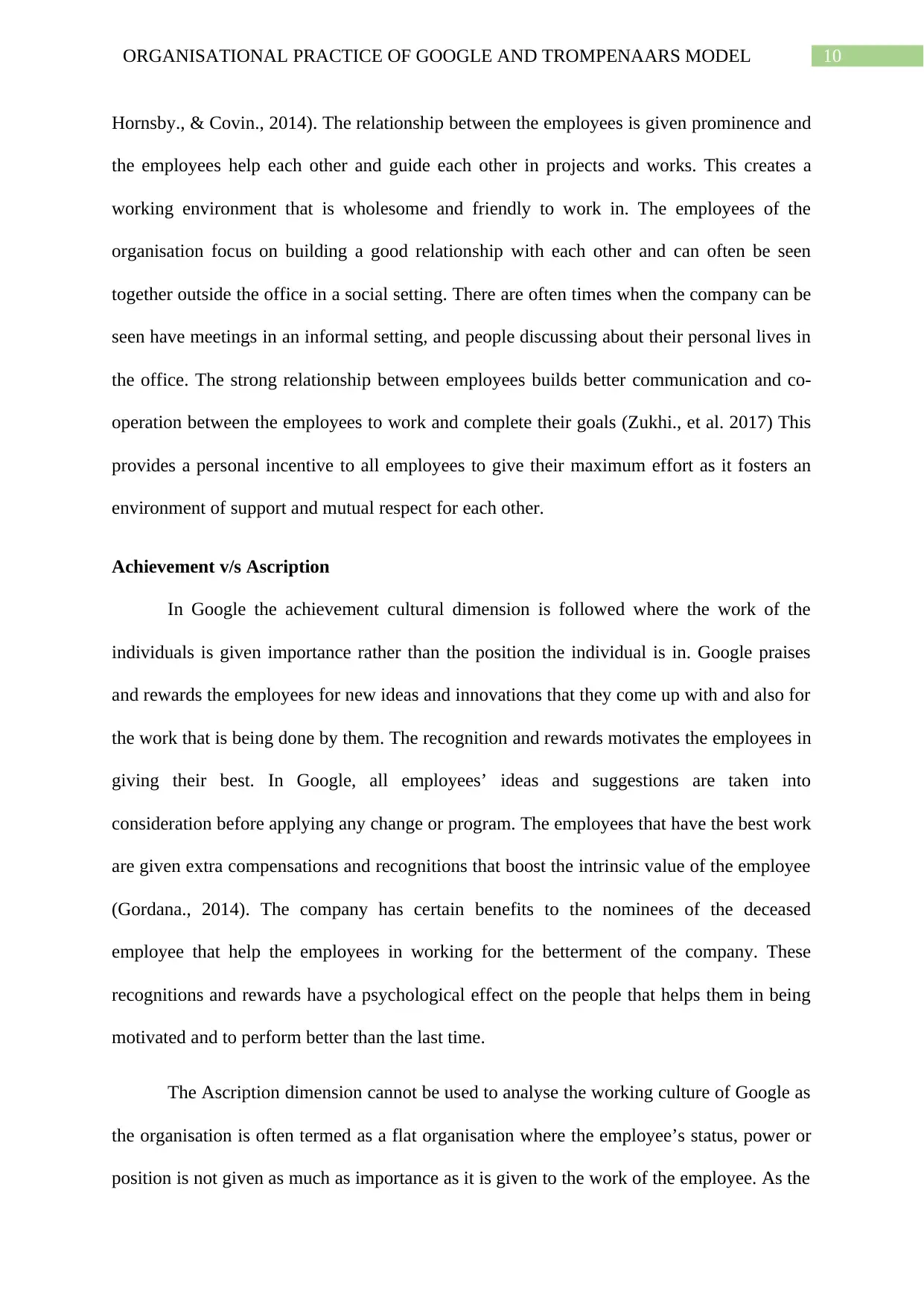
10ORGANISATIONAL PRACTICE OF GOOGLE AND TROMPENAARS MODEL
Hornsby., & Covin., 2014). The relationship between the employees is given prominence and
the employees help each other and guide each other in projects and works. This creates a
working environment that is wholesome and friendly to work in. The employees of the
organisation focus on building a good relationship with each other and can often be seen
together outside the office in a social setting. There are often times when the company can be
seen have meetings in an informal setting, and people discussing about their personal lives in
the office. The strong relationship between employees builds better communication and co-
operation between the employees to work and complete their goals (Zukhi., et al. 2017) This
provides a personal incentive to all employees to give their maximum effort as it fosters an
environment of support and mutual respect for each other.
Achievement v/s Ascription
In Google the achievement cultural dimension is followed where the work of the
individuals is given importance rather than the position the individual is in. Google praises
and rewards the employees for new ideas and innovations that they come up with and also for
the work that is being done by them. The recognition and rewards motivates the employees in
giving their best. In Google, all employees’ ideas and suggestions are taken into
consideration before applying any change or program. The employees that have the best work
are given extra compensations and recognitions that boost the intrinsic value of the employee
(Gordana., 2014). The company has certain benefits to the nominees of the deceased
employee that help the employees in working for the betterment of the company. These
recognitions and rewards have a psychological effect on the people that helps them in being
motivated and to perform better than the last time.
The Ascription dimension cannot be used to analyse the working culture of Google as
the organisation is often termed as a flat organisation where the employee’s status, power or
position is not given as much as importance as it is given to the work of the employee. As the
Hornsby., & Covin., 2014). The relationship between the employees is given prominence and
the employees help each other and guide each other in projects and works. This creates a
working environment that is wholesome and friendly to work in. The employees of the
organisation focus on building a good relationship with each other and can often be seen
together outside the office in a social setting. There are often times when the company can be
seen have meetings in an informal setting, and people discussing about their personal lives in
the office. The strong relationship between employees builds better communication and co-
operation between the employees to work and complete their goals (Zukhi., et al. 2017) This
provides a personal incentive to all employees to give their maximum effort as it fosters an
environment of support and mutual respect for each other.
Achievement v/s Ascription
In Google the achievement cultural dimension is followed where the work of the
individuals is given importance rather than the position the individual is in. Google praises
and rewards the employees for new ideas and innovations that they come up with and also for
the work that is being done by them. The recognition and rewards motivates the employees in
giving their best. In Google, all employees’ ideas and suggestions are taken into
consideration before applying any change or program. The employees that have the best work
are given extra compensations and recognitions that boost the intrinsic value of the employee
(Gordana., 2014). The company has certain benefits to the nominees of the deceased
employee that help the employees in working for the betterment of the company. These
recognitions and rewards have a psychological effect on the people that helps them in being
motivated and to perform better than the last time.
The Ascription dimension cannot be used to analyse the working culture of Google as
the organisation is often termed as a flat organisation where the employee’s status, power or
position is not given as much as importance as it is given to the work of the employee. As the
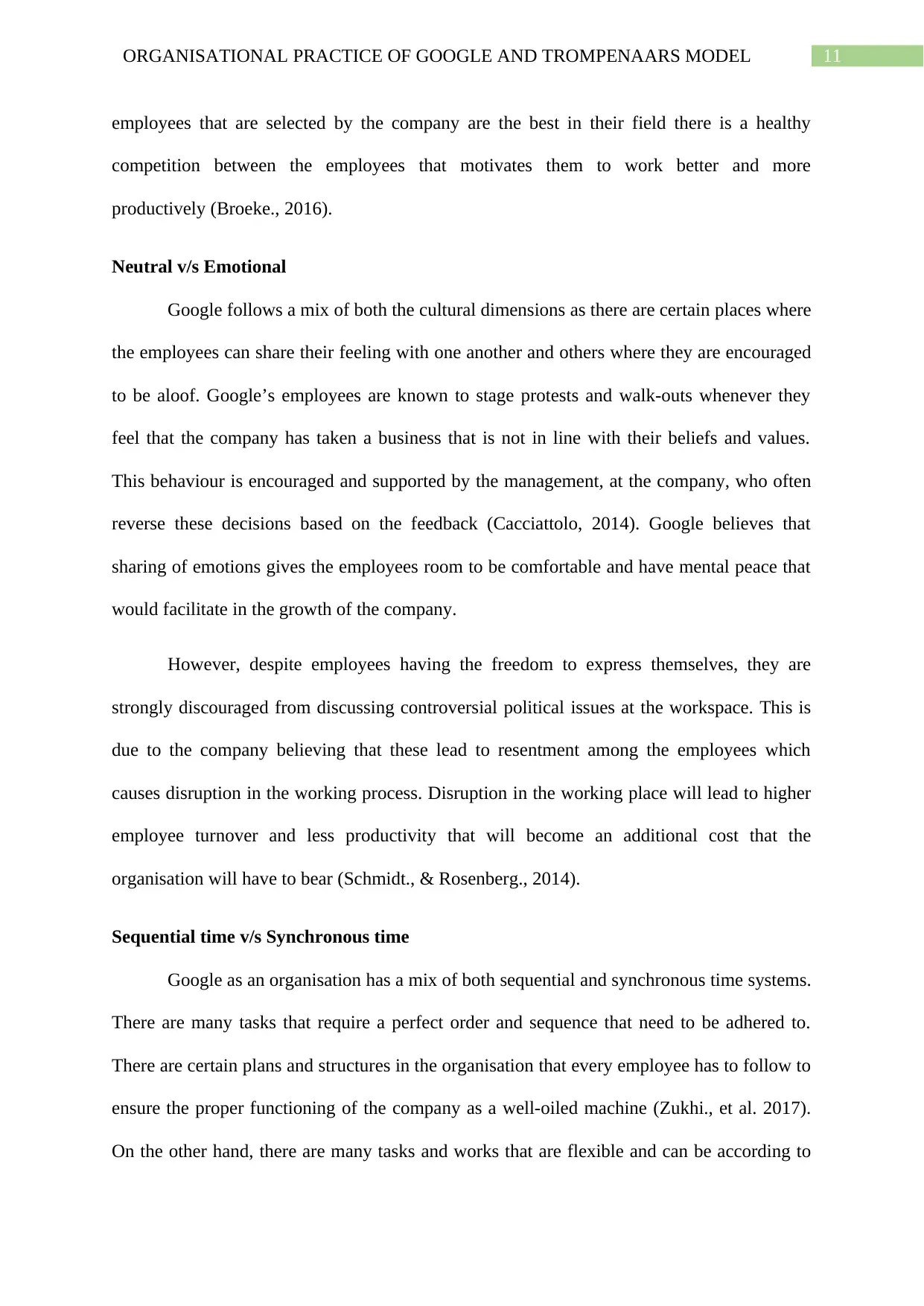
11ORGANISATIONAL PRACTICE OF GOOGLE AND TROMPENAARS MODEL
employees that are selected by the company are the best in their field there is a healthy
competition between the employees that motivates them to work better and more
productively (Broeke., 2016).
Neutral v/s Emotional
Google follows a mix of both the cultural dimensions as there are certain places where
the employees can share their feeling with one another and others where they are encouraged
to be aloof. Google’s employees are known to stage protests and walk-outs whenever they
feel that the company has taken a business that is not in line with their beliefs and values.
This behaviour is encouraged and supported by the management, at the company, who often
reverse these decisions based on the feedback (Cacciattolo, 2014). Google believes that
sharing of emotions gives the employees room to be comfortable and have mental peace that
would facilitate in the growth of the company.
However, despite employees having the freedom to express themselves, they are
strongly discouraged from discussing controversial political issues at the workspace. This is
due to the company believing that these lead to resentment among the employees which
causes disruption in the working process. Disruption in the working place will lead to higher
employee turnover and less productivity that will become an additional cost that the
organisation will have to bear (Schmidt., & Rosenberg., 2014).
Sequential time v/s Synchronous time
Google as an organisation has a mix of both sequential and synchronous time systems.
There are many tasks that require a perfect order and sequence that need to be adhered to.
There are certain plans and structures in the organisation that every employee has to follow to
ensure the proper functioning of the company as a well-oiled machine (Zukhi., et al. 2017).
On the other hand, there are many tasks and works that are flexible and can be according to
employees that are selected by the company are the best in their field there is a healthy
competition between the employees that motivates them to work better and more
productively (Broeke., 2016).
Neutral v/s Emotional
Google follows a mix of both the cultural dimensions as there are certain places where
the employees can share their feeling with one another and others where they are encouraged
to be aloof. Google’s employees are known to stage protests and walk-outs whenever they
feel that the company has taken a business that is not in line with their beliefs and values.
This behaviour is encouraged and supported by the management, at the company, who often
reverse these decisions based on the feedback (Cacciattolo, 2014). Google believes that
sharing of emotions gives the employees room to be comfortable and have mental peace that
would facilitate in the growth of the company.
However, despite employees having the freedom to express themselves, they are
strongly discouraged from discussing controversial political issues at the workspace. This is
due to the company believing that these lead to resentment among the employees which
causes disruption in the working process. Disruption in the working place will lead to higher
employee turnover and less productivity that will become an additional cost that the
organisation will have to bear (Schmidt., & Rosenberg., 2014).
Sequential time v/s Synchronous time
Google as an organisation has a mix of both sequential and synchronous time systems.
There are many tasks that require a perfect order and sequence that need to be adhered to.
There are certain plans and structures in the organisation that every employee has to follow to
ensure the proper functioning of the company as a well-oiled machine (Zukhi., et al. 2017).
On the other hand, there are many tasks and works that are flexible and can be according to

12ORGANISATIONAL PRACTICE OF GOOGLE AND TROMPENAARS MODEL
the employees own time management and preferences. This mixed approach benefits the
organisation in working towards the company’s goals and objectives while also in developing
and innovating new products and ideas at the same time (Bock., 2015). The employees feel
that they are a part of the organisation as they can have flexible working hours that are
according to their own wishes and requirements however, they have certain time quotas that
they need to adhere to and fulfil.
Conclusion
From the above discussion in the report it can be concluded that Google as an
organisation has a working environment that encourages and motivates their employees. The
company is regarded as one of the best places to work in today’s time. The working culture
and environment of the company is analysed by applying the Trompenaars Model and its
dimensions. In this report four dimensions are used that are specific v/s diffuse, achievement
v/s ascription, neutral v/s emotional and sequential time v/s synchronous time. It can be
concluded that Google has a diffused working environment where achievement is given more
focus on, with the mix of neutral and emotional culture and also a mix of sequential time and
synchronous time dimensions. The culture and the organisational practice that the company
follows has allowed it to get to where it is today and become of the technology giants of the
world.
Recommendations
There are many systems that the company can follow and apply in their organisational
structure to continue to be successful in the future.
The leadership style of the company can be improved as in the middle
management there is a lot of politics that hampers the growth of the company.
the employees own time management and preferences. This mixed approach benefits the
organisation in working towards the company’s goals and objectives while also in developing
and innovating new products and ideas at the same time (Bock., 2015). The employees feel
that they are a part of the organisation as they can have flexible working hours that are
according to their own wishes and requirements however, they have certain time quotas that
they need to adhere to and fulfil.
Conclusion
From the above discussion in the report it can be concluded that Google as an
organisation has a working environment that encourages and motivates their employees. The
company is regarded as one of the best places to work in today’s time. The working culture
and environment of the company is analysed by applying the Trompenaars Model and its
dimensions. In this report four dimensions are used that are specific v/s diffuse, achievement
v/s ascription, neutral v/s emotional and sequential time v/s synchronous time. It can be
concluded that Google has a diffused working environment where achievement is given more
focus on, with the mix of neutral and emotional culture and also a mix of sequential time and
synchronous time dimensions. The culture and the organisational practice that the company
follows has allowed it to get to where it is today and become of the technology giants of the
world.
Recommendations
There are many systems that the company can follow and apply in their organisational
structure to continue to be successful in the future.
The leadership style of the company can be improved as in the middle
management there is a lot of politics that hampers the growth of the company.
Paraphrase This Document
Need a fresh take? Get an instant paraphrase of this document with our AI Paraphraser
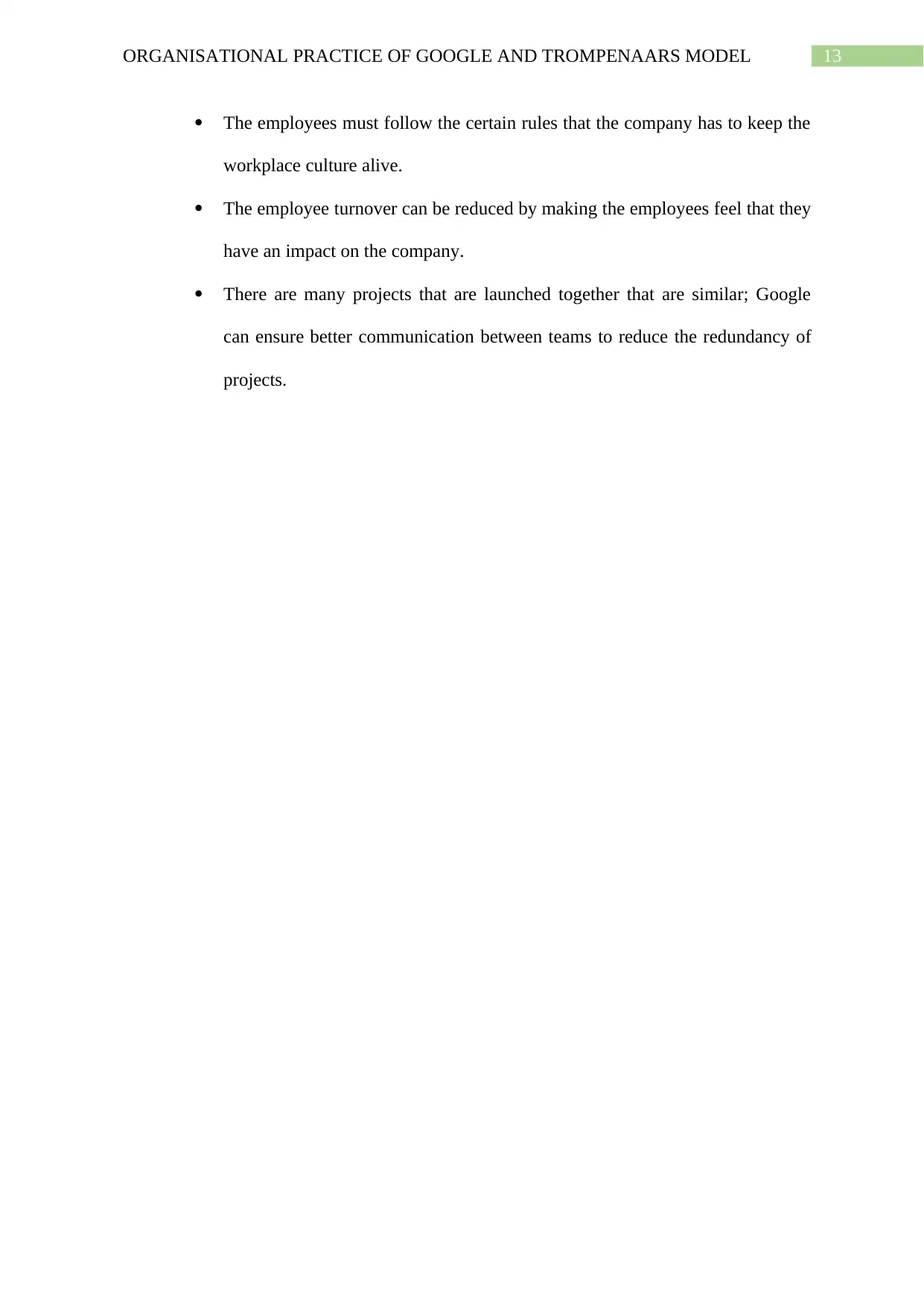
13ORGANISATIONAL PRACTICE OF GOOGLE AND TROMPENAARS MODEL
The employees must follow the certain rules that the company has to keep the
workplace culture alive.
The employee turnover can be reduced by making the employees feel that they
have an impact on the company.
There are many projects that are launched together that are similar; Google
can ensure better communication between teams to reduce the redundancy of
projects.
The employees must follow the certain rules that the company has to keep the
workplace culture alive.
The employee turnover can be reduced by making the employees feel that they
have an impact on the company.
There are many projects that are launched together that are similar; Google
can ensure better communication between teams to reduce the redundancy of
projects.

14ORGANISATIONAL PRACTICE OF GOOGLE AND TROMPENAARS MODEL
References
About Google. (2020). Google - About. Retrieved 30 January 2020, from
https://about.google/
Bock, L., 2015. Work rules!: Insights from inside Google that will transform how you live
and lead. Twelve.
Broeke, K., 2016. American and German Culture. A comparison by using one aspect of
Trompenaars' model of culture. Anchor Academic Publishing.
Cacciattolo, K. (2014). Understanding organisational cultures. European scientific journal,
2(1), 1-7.
Eringa, K., Caudron, L.N., Rieck, K., Xie, F. & Gerhardt, T., 2015. How relevant are
Hofstede's dimensions for inter-cultural studies? A replication of Hofstede's research
among current international business students. Research in Hospitality Management,
5(2), pp.187-198.
Gordana, N.M.S., 2014. Montenegrin national culture through Fons Trompenaars''model.
Экономика и предпринимательство, (6), pp.268-273.
Kuratko, D.F., Hornsby, J.S. & Covin, J.G., 2014. Diagnosing a firm's internal environment
for corporate entrepreneurship. Business Horizons, 57(1), pp.37-47.
McSweeney, B., 2016. Hall, Hofstede, Huntington, Trompenaars, GLOBE: Common
Foundations, Common Flaws. In Transculturalism and Business in the BRIC States
(pp. 39-84). Routledge.
References
About Google. (2020). Google - About. Retrieved 30 January 2020, from
https://about.google/
Bock, L., 2015. Work rules!: Insights from inside Google that will transform how you live
and lead. Twelve.
Broeke, K., 2016. American and German Culture. A comparison by using one aspect of
Trompenaars' model of culture. Anchor Academic Publishing.
Cacciattolo, K. (2014). Understanding organisational cultures. European scientific journal,
2(1), 1-7.
Eringa, K., Caudron, L.N., Rieck, K., Xie, F. & Gerhardt, T., 2015. How relevant are
Hofstede's dimensions for inter-cultural studies? A replication of Hofstede's research
among current international business students. Research in Hospitality Management,
5(2), pp.187-198.
Gordana, N.M.S., 2014. Montenegrin national culture through Fons Trompenaars''model.
Экономика и предпринимательство, (6), pp.268-273.
Kuratko, D.F., Hornsby, J.S. & Covin, J.G., 2014. Diagnosing a firm's internal environment
for corporate entrepreneurship. Business Horizons, 57(1), pp.37-47.
McSweeney, B., 2016. Hall, Hofstede, Huntington, Trompenaars, GLOBE: Common
Foundations, Common Flaws. In Transculturalism and Business in the BRIC States
(pp. 39-84). Routledge.
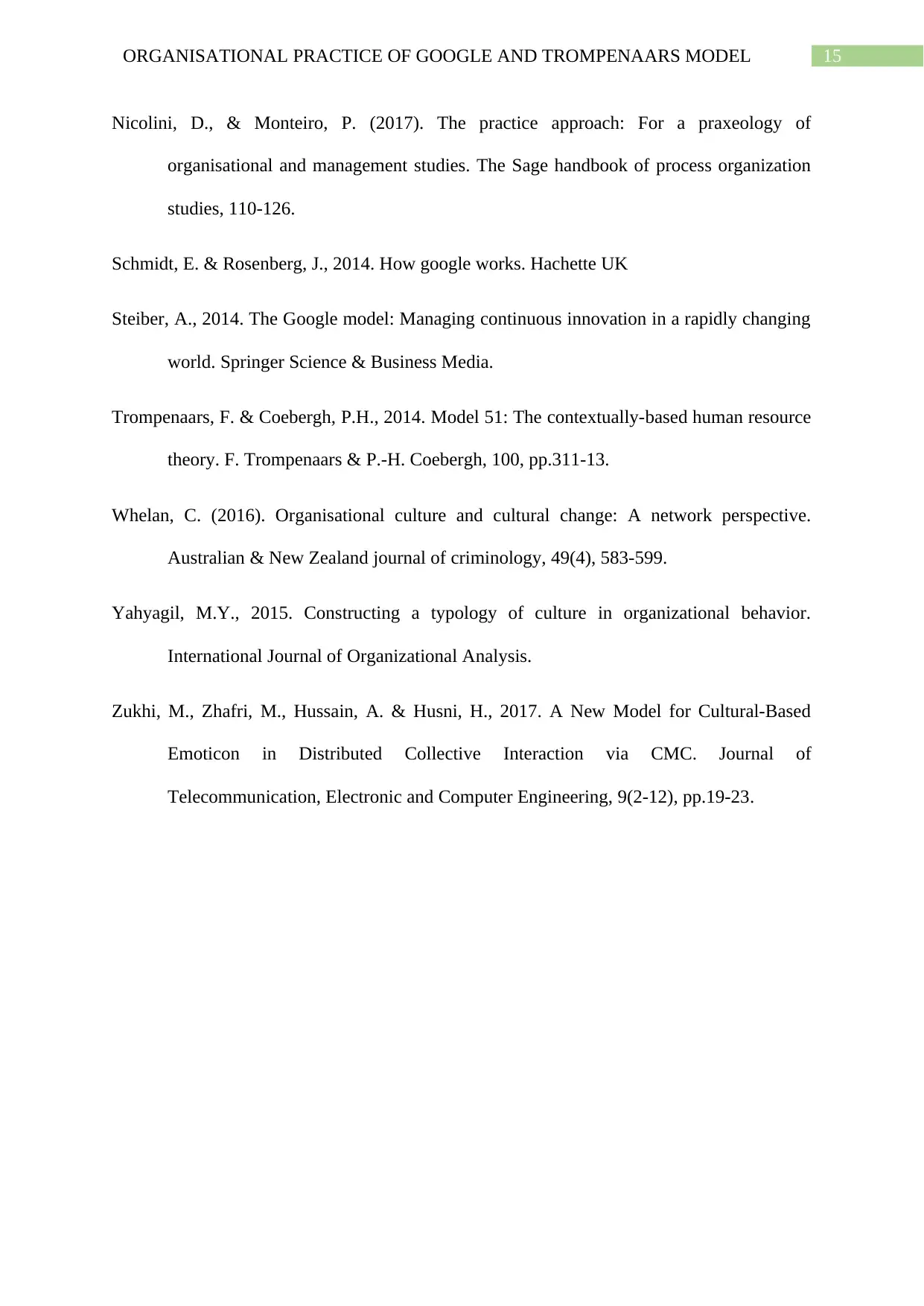
15ORGANISATIONAL PRACTICE OF GOOGLE AND TROMPENAARS MODEL
Nicolini, D., & Monteiro, P. (2017). The practice approach: For a praxeology of
organisational and management studies. The Sage handbook of process organization
studies, 110-126.
Schmidt, E. & Rosenberg, J., 2014. How google works. Hachette UK
Steiber, A., 2014. The Google model: Managing continuous innovation in a rapidly changing
world. Springer Science & Business Media.
Trompenaars, F. & Coebergh, P.H., 2014. Model 51: The contextually-based human resource
theory. F. Trompenaars & P.-H. Coebergh, 100, pp.311-13.
Whelan, C. (2016). Organisational culture and cultural change: A network perspective.
Australian & New Zealand journal of criminology, 49(4), 583-599.
Yahyagil, M.Y., 2015. Constructing a typology of culture in organizational behavior.
International Journal of Organizational Analysis.
Zukhi, M., Zhafri, M., Hussain, A. & Husni, H., 2017. A New Model for Cultural-Based
Emoticon in Distributed Collective Interaction via CMC. Journal of
Telecommunication, Electronic and Computer Engineering, 9(2-12), pp.19-23.
Nicolini, D., & Monteiro, P. (2017). The practice approach: For a praxeology of
organisational and management studies. The Sage handbook of process organization
studies, 110-126.
Schmidt, E. & Rosenberg, J., 2014. How google works. Hachette UK
Steiber, A., 2014. The Google model: Managing continuous innovation in a rapidly changing
world. Springer Science & Business Media.
Trompenaars, F. & Coebergh, P.H., 2014. Model 51: The contextually-based human resource
theory. F. Trompenaars & P.-H. Coebergh, 100, pp.311-13.
Whelan, C. (2016). Organisational culture and cultural change: A network perspective.
Australian & New Zealand journal of criminology, 49(4), 583-599.
Yahyagil, M.Y., 2015. Constructing a typology of culture in organizational behavior.
International Journal of Organizational Analysis.
Zukhi, M., Zhafri, M., Hussain, A. & Husni, H., 2017. A New Model for Cultural-Based
Emoticon in Distributed Collective Interaction via CMC. Journal of
Telecommunication, Electronic and Computer Engineering, 9(2-12), pp.19-23.
1 out of 16
Related Documents
Your All-in-One AI-Powered Toolkit for Academic Success.
+13062052269
info@desklib.com
Available 24*7 on WhatsApp / Email
![[object Object]](/_next/static/media/star-bottom.7253800d.svg)
Unlock your academic potential
© 2024 | Zucol Services PVT LTD | All rights reserved.





